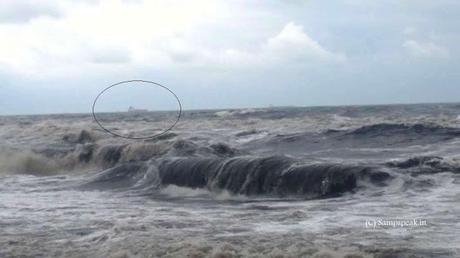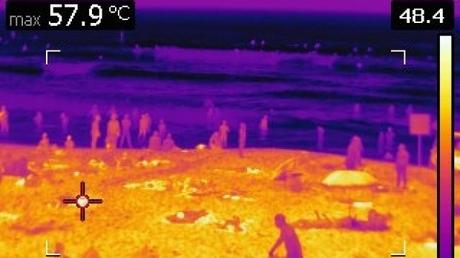 Downunder,
Sydney is in for scorching weather on Friday as a slow-moving high-pressure
system steers a huge hot air mass formed over Australia's Red Centre into the
country's south-east.The Bureau of Meteorology said temperatures were expected
to soar to 41 degrees in the city on Friday, pushing the mercury to levels
reached only once before in November – back in 1982, when it hit 41.8 degrees.
If
the sea breezes are kept at bay as expected, temperatures will be fairly
uniform across the Sydney Basin. Bondi is expected to reach 41 degrees, as is
Penrith, some 50 kilometres to the west. A 40-plus reading would be enough to
make it Sydney's hottest three-day spell in November in 79 years, Weatherzone
said. Sydney Morning Herald reported that the city came to a rapid boil this
afternoon, the mercury surging 10C in less than an hour as temperatures soared
past 42C at Sydney Airport and a host of other suburbs approached 40C as the
city approached the record for the hottest November Day.BOM forecaster Chris Webb
said the temperature in the Sydney CBD increased more than 10 degrees in just
45 minutes.
There
is no Ramanan out there [there is so much meme on social media as students
reportedly thanked Mr Ramanan for predicting more rains !] – a spokesman for the NSW Department of Education is
quoted as saying that there were no
plans to close schools due to heat on Friday, dispelling a myth that there is a
set temperature that forces a school to close."Schools are closed only in
extreme circumstances, such as during fire or flood or for health and safety
reasons. Hot weather is generally not considered to be an emergency," he
said.
This
year too the summer in Chennai was felt oppressive. In mid-May 2015, the maximum temperature peaked to 41.1° Celsius at
Nungambakkam, the mercury level touched 40° Celsius at Meenambakkam.Residents and
those who by nature of their work had to be outside had to bear with the hot
winds and searing heat. In 2014, the
maximum temperature in Chennai city peaked to 42.8 degree Celsius. This year saw heatwaves and many losing their
lives in various parts fo the Nation. In
Nandigama, in Andhra Pradesh, temperature crawled past 47 degrees. There were many deaths reported in Andhra and
Telengana. Meantime, Delhi seared to its
hottest this summer with the temperature a blistering 45.5 degrees. The majority of the victims were people who were
exposed to the sun directly, usually
aged 50 and above and from the working classes.
Downunder,
Sydney is in for scorching weather on Friday as a slow-moving high-pressure
system steers a huge hot air mass formed over Australia's Red Centre into the
country's south-east.The Bureau of Meteorology said temperatures were expected
to soar to 41 degrees in the city on Friday, pushing the mercury to levels
reached only once before in November – back in 1982, when it hit 41.8 degrees.
If
the sea breezes are kept at bay as expected, temperatures will be fairly
uniform across the Sydney Basin. Bondi is expected to reach 41 degrees, as is
Penrith, some 50 kilometres to the west. A 40-plus reading would be enough to
make it Sydney's hottest three-day spell in November in 79 years, Weatherzone
said. Sydney Morning Herald reported that the city came to a rapid boil this
afternoon, the mercury surging 10C in less than an hour as temperatures soared
past 42C at Sydney Airport and a host of other suburbs approached 40C as the
city approached the record for the hottest November Day.BOM forecaster Chris Webb
said the temperature in the Sydney CBD increased more than 10 degrees in just
45 minutes.
There
is no Ramanan out there [there is so much meme on social media as students
reportedly thanked Mr Ramanan for predicting more rains !] – a spokesman for the NSW Department of Education is
quoted as saying that there were no
plans to close schools due to heat on Friday, dispelling a myth that there is a
set temperature that forces a school to close."Schools are closed only in
extreme circumstances, such as during fire or flood or for health and safety
reasons. Hot weather is generally not considered to be an emergency," he
said.
This
year too the summer in Chennai was felt oppressive. In mid-May 2015, the maximum temperature peaked to 41.1° Celsius at
Nungambakkam, the mercury level touched 40° Celsius at Meenambakkam.Residents and
those who by nature of their work had to be outside had to bear with the hot
winds and searing heat. In 2014, the
maximum temperature in Chennai city peaked to 42.8 degree Celsius. This year saw heatwaves and many losing their
lives in various parts fo the Nation. In
Nandigama, in Andhra Pradesh, temperature crawled past 47 degrees. There were many deaths reported in Andhra and
Telengana. Meantime, Delhi seared to its
hottest this summer with the temperature a blistering 45.5 degrees. The majority of the victims were people who were
exposed to the sun directly, usually
aged 50 and above and from the working classes.
According to the Indian Meteorological Department (IMD), a heat wave is qualified when air temperatures of at least 40 °C (104 °F) in the plains or greater than 30 °C (86 °F) in the hilly regions. For the IMD classification of heat waves, temperatures greater than 46 °C (114.8 °F) are considered and classified as severe heat waves. Every year India experiences severe heat waves in summer, but in the year 2015, casualties were abnormally high. Moving away, in Aug 2015 : A city in Iran experienced what is believed to be history’s second highest temperature ever as a blistering heatwave lingered over the Middle East.The air in Bandar Mahshahr in the Persian Gulf recorded a sweltering "heat index" of 74°C (165°F). The ancient city and port of Bandar Mahshahr sits on the coast in the south-west corner of Iran, where water temperatures are regularly in the 30s. During that time, the Iraqi government ordered a four-day public holiday to help people deal with the heatwave. It's hot, but some places are hotter than others. Shade, vegetation, building materials and the sea breeze create huge variations in temperature even within short distances. An interesting report in today’s SMH states :If you really want to know how hot you are, try getting around the city with Jonathan Fox, an expert in urban microclimates armed with an infrared camera and a hand-held weather station, the Kestrel 4000. His PhD at the University of NSW Australia is looking at how different building facades - their colour, position, geometry, material density and so on - affect the outdoor "thermal comfort" of pedestrians and passers-by. Before climate change, no one thought too much about it, and building materials weren't generally chosen for their cooling properties. (Rule No.1: the lighter the colour, the better).Mr Fox's aim is to create a tool to help designers make buildings which keep our cities cooler. .. ~ and at a time, when media wrote about 41 deg C – in the Sydney Fish Market's car park at 11.15am, the infrared camera read 57.7 degrees, just a fraction cooler than the sand on Bondi Beach, where it measured 57.9 degrees.
 With
regards – S. Sampathkumar
With
regards – S. Sampathkumar
20th Nov. 2015.

